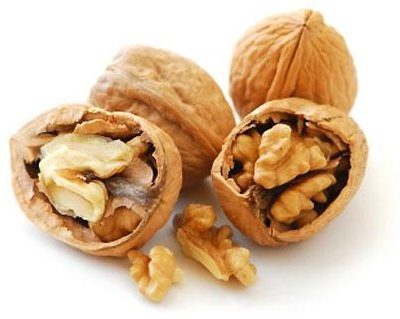

Walnut
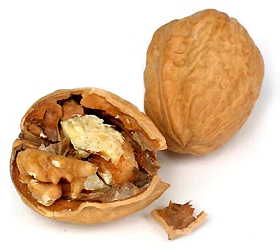
Juglans. (From Latin Jovis glans.) WALNUT. Juglandaceae. About 15 species of deciduous, monoecious trees, rarely shrubs. Bark scaly, furrowed; branches with chambered pith; buds few scaled, sessile, rarely short-stalked. Leaves alternate, bipinnate, exstipulate; leaflets serrate to entire. Staminate flowers in axillary catkins with single bracts, corolla 3-6-lobed, stamens 8-40; pistillate flowers in terminal spikes, corolla 4-lobed, adnate to ovary; styles 2, short; stigmas fimbricate. Fruit a drupe, indehiscent; pericarp thick, fibrous, furrowed, 2-4-celled; seed 2-4-lobed. Late spring. N & S America, SE Europe, Asia. CultivationJuglans species are valuable landscape trees for plantings in open spaces where there is room to appreciate the tall and straight boles of fissured and patterned bark and the domed crowns of long, pinnate leaves which, in most species, are aromatic when crushed. Juglans regia and Juglans nigra, in particular, make fine specimens for avenue plantings, the latter a fast-growing tree on rich, damp soils in its native range, from Massachusetts to Florida, west to Minnesota and Texas. Juglans regia is thought to have originated in Iran and the Balkans, although both the species and its subspecies range through SE Europe to the Himalaya, N Burma and SW China. Smaller but more frost-tender species such as Juglans californica and Juglans hindsii are frequently planted as street trees in warm climates such as California, but they will not thrive if winter temperatures fall below -12ºC; Asian species often show similar frost sensitivity. The young growth of most species remains prone to damage by late spring frosts, although in the genus as a whole, spring flushing is relatively late. Substances produced by the roots of many Juglans species, notably Juglans regia and Juglans nigra, appear to have toxic effects (allelopathy) for a variety of plants, particularly members of the Ericaceae, Potentilla, apples and white pines, which precludes underplanting with these subjects. All species produce edible nuts but quality is highest in commercially selected cultivars of Juglans regia. bearing commences between 6-15 years of age, and may be irregular due to a number of factors. It seems likely that flower initiation is dependent on suitable conditions the previous summer, and flowers and young growth are destroyed by even short periods (hours) with temperatures to between -2ºC and -3ºC. Although walnuts are self-fertile, in some individuals male and female flowers mature at different times and pollination may not occur in solitary trees. While fruit ripening may be poor in cool damp climates such as Northern Britain, walnuts can nevertheless yield a good harvest of nuts for pickling, gathered before the development of the hard shell. However, walnuts are cultivated as far north as Warsaw, and in recent years Polish cultivars (e.g. the Juglans regia Carpathian Group) have yielded promising results for cold temperature zones, cropping heavily even when subject to severe winter cold. Increased interest is being shown in Australia, where ‘Franquette’, a comparatively old French cultivar (on Juglans Nigra rootstock), reliable, late-flowering, and of excellent quality, is widely planted. 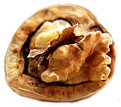
Plant in the dormant season in deep, well-drained but moderately moist, fertile and slightly alkaline soils; perfect drainage is essential for Juglans regia. Juglans cinerea and Juglans nigra demand much higher levels of soil moisture, but none will tolerate poor or wet subsoils. Where pruning is necessary, do so in late summer/early autumn when the tree is in full leaf, or when completely dormant, otherwise wounds bleed profusely. For fruit production, Juglans regia may be pruned to a vase or cup-shaped framework when young and, in the smaller garden, trees may be kep relatively dwarfed by pruning. Propagate by seed sown ripe, or stratified in autumn and sown in spring, in a sandy, humus-rich propagating medium. Seed dormancy is broken at temperatures of 5-6ºC. Protect from rodents, and move seedlings on as soon as possible to nursery beds and to final positions, since Juglans develop deep taproots which make transplanting difficult. Cultivars will not come true from seed; propagate by splice or veneer grafting on to seedling stock of Juglans regia or Juglans hindsii under glass in winter, or by flute budding on to nursery-grown seedling stock in summer. For heavier soils, Juglans nigra is the preferred rootstock. Leaf blotch caused by the fungus Gnominia leptostyla can result in premature defoliation. Small dark spots on the leaves enlarge to become blotches which are yellow on the upper surface and grey below; lesions may also occur on the young green nuts and on the shoots. Bacterial leaf blight, Xanthomonas juglandis, causes small angular black spots on the leaves and can also attack fruit, although in Britain it is mainly a disease of nursery stock. Control of these diseases is impractical on large trees, but small manageable trees can be treated with an appropriate fungicide, spraying from bud break to midsummer; collect and burn infected foliage. Coral spot, Nectria cinnabarina, causes wilt, dieback and canker, and probably invades via pruning cuts and possibly frost damage; cut out affected parts. Nut rot may occur in wet seasons, including a soft shell condition predisposing to attack by grey mould, Botrytis cinerea; do not store affected nuts. Walnuts can also be affected by armillaria root rot (Armillaria species) and heart rot (Lonotus hispidus, Polyporus squamosus). Witches broom on walnuts may be caused by a mycoplasma. Crown gall, Agrobacterium radiobacter variety tumefaciens, is sometimes found at the root to stem junction, where galls up to 1m in diameter may be produced, but this is rarely threatening, and such ‘burrs’ my yield exceptionally well figured wood. 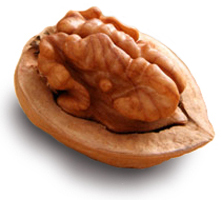
The trees may be attacked by two species of walnut aphids (Callipterus juglandis and Chromaphis juglandicola) - the former is a European species and the latter occurs in both Europe and North America. Blister-like growths on the leaves are caused by the walnut blister mite (Aceria tristriata), which is widespread in Europe and Asia and has been introduced into Australia. Additional North American pests include the walnut caterpillar (Datana integerrima) with black, grey-haired larvae, up to 50mm long when fully grown, that feed openly on the foliage; the walnut husk fly (Rhageoletis species), a fruit fly with larvae which tunnel into the green husks turning them black and slimy; and two species of weevils, the black walnut curculio (Conotrachelus retentus) and the butternut curculio (Conotrachelus juglandis), with larvae which burrow into the nuts. Juglans ailanthifoliaJAPANESE WALNUT; HEARTNUT. To 15m. Crown broad; young branches glandular-pubescent. Leaves to 50cm or occasionally more; leaflets 11-17, to 15 x 5cm, oblong to elliptic, acuminate, base oblique to cordate, serrate, deep green, grey-tomentose to glabrous above, glandular-pubescent, beneath. Male inflorescence to 25cm, female inflorescence with up to 20 flowers. Fruit globose to ovate, glutinose-pubescent; nut to 3cm with thick ridges at apex. Japan. variety cordiformis. Leaves narrower. Nut to 3cm, compressed, distinctly bisymmetrical, thin-shelled. Hybrids between Juglans ailanthifolia and Juglans cinerea (sometimes called ‘Fioka’, heavy and annual cropper ‘Mitchell’, very hardy. Z4. Juglans californicaCALIFORNIA WALNUT. Similar to Juglans hindsii but shrub or small tree to 9m; leaflets 9-15, to 13cm, ovate; fruit small, to 1.5cm; nuts more deeply grooved. W US. Z8. Juglans catheyensisCHINESE WALNUT; CHINESE BUTTERNUT. Shrub or tree to 23m. Young branches sticky-pubescent. Leaves to 80cm; rachis sticky-pubescent; leaflets 11-19, to 15 x 8cm, oblong-lanceolate, base oblique to cordate, finely dentate, deep green and pubescent above, lighter and stellate-pubescent beneath. Female inflorescence racemose; male inflorescence to 30cm. Fruit ovoid, to 4.5cm, in clusters of 6-10; stalk to 15cm; nut 6-8 angled, spiny-ridged; shell 3-4mm thick. C and W China, Taiwan. Z5. Juglans cinerea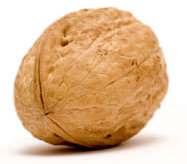
BUTTERNUT; WHITE WALNUT. To 30m. bark grey to red-brown, deeply furrowed, pubescent, glandular-glutinose when young. leaves 25-50cm; rachis glandular; leaflets 11-19, 6-12cm, oblong-lanceolate, acuminate, adpressed irregular-serrate, pubescent, glandular beneath, terminal leaflet present. Fruit in clusters of 2-5, to 10cm, glandular-glutinose; nut oblong, brown-black, with rough, sharp sometimes broken ridges. NE US. Z4. Juglans hindsiiTo 10-15m. Crown round; young branches desnely pubescent. Leaves 25-30cm; petiole villous; leaflets 15-19, to 10 x 2.5cm, ovate-lanceolate to lanceolate, acuminate, rounded at base, coarsely serrate, veins pubescent beneath. Fruit globose, pubescent; nuts 1, 2.5-3cm wide. N and C CAlifornia. Z8. Juglans x intermedia(juglans nigra x Juglans regia) Similar to Juglans regia but leaflets 11, ovate to elliptic, remotely denticulate, dark green and glabrous above, axillary tufts of hair beneath; fruit smooth, deeply grooved. variety pyriformis. Leaflets 9-13, finely dentate. Fruit obovoid. variety vilmoreana. Fruit globose. Z5. Juglans jamaicensisWEST INDIAN WALNUT; NOGAL; PALO DE NUZ. To 45m. Twigs red-glandular-pubescent; buds terminal, elongate. Leaves elongate, to 55 x 25cm; leaflets 16-20, to 11 x 4.5cm, opposite or alternate, oblong to ovate-lanceolate, terminal leaflet absent. Male inflorescence to 13 x 2cm, bract small, slender or triangular, stamens 60-85; female inflorescence to 8cm, ovaries minutely pubescent; nut red-brown to black, subglobose to subconical, heavily longitudinally ridged. Puerto Rico, Dominican Republic, Haiti, Cuba. Z10.  Juglans major
Juglans major
To 15m. Crown narrow; young branches pubescent. Leaflets opposite, 9-13, 7-10cm, oblong-lanceolate to ovate, acuminate, base cuneate or rounded, coarsley serrate, glabrous, occasionally pubescent beneath, basal pair shorter. Stamens 30-40. Fruit globose to ovoid, to 3cm wide, rust-brown pubescent; nuts brown to black, subglobose, deeply grooved, shell thick. W Texas, New Mexico, Arizona, Mexico. Z9. Juglans mandshuricaMANCHURIAN WALNUT. To 20m. Branches glandular pubescent, green, yellow in second year; shoots suckering. Leaves 45-50cm; petiole and midrib glandular-pubescent; leaflets 9-17, 6-13cm, oblong, subsessile, becoming glabrous above, glandular pubescent beneath. Fruit in short racemes, globose to obovoid, pointed, to 5cm; nut ovoid, pointed, with several sharp ridges. NE China, Korea. Z5. Juglans microcarpaSimilar to Juglans major but shrub or small tree, to 7m; young shoots grey-brown to grey; leaflets 15-23, finely serrate; stamens up to 20; fruit thinner. Texas, New Mexico, NE Mexico. Z6. Juglans neotropicaTo 30m. Bark grey-brown, somewhat fissured, smooth when young; twigs pubescent becoming red-glandular-pubescent, lenticulate; terminal bud slender, pointed. Leaves 34 x 18-60 x 30cm; leaflets 12-19, about 11 x 5cm, opposite, nearly sessile, ovate to ovate-oblong, rugose, coarsely serrate, midrib and main veins red-glandular-pubescent above, scattered pubescent beneath. Female flowers with elongated sepals, ovary densely tomentose. Fruit subglobose, about 4 x 3.5cm; nut subglobose, black. Venezuela, Colombia, Ecuador, Peru. Z10. 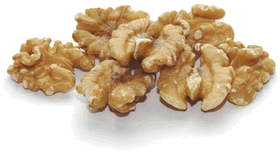 Juglans nigra
Juglans nigra
BLACK WALNUT. To 45m. Leaves paripinnate; leaflets 15-23, to 11cm, ovate-oblong, pubescent beneath, no terminal leaflet. Fruit globose, about 4cm diameter, pubescent; nut subglobose to ovoid, pointed, to 3cm, deeply ridged, shell thick. E US, naturalised C Europe. ‘Lacinata’: leaflets lacinate. Z4. Juglans x notha(Juglans ailanthifolia x Juglans regia.) Leaflets 7-9, elliptic to elliptic-oblong, glabrous above, glabrous to pubescent beneath, margins finely and sparingly denticulate. Fruit globose to ovate, sticky-pubescent; nut globose to ovate, pointed, with thick ridges toward apex. Z5. Juglans x quadrangulata(Juglans cinerea x Juglans regis). Similar to Juglans regia but leaflets usually 9, elliptic to oblong, sparsely serrate, pubescent beneath. Fruit subglobose, about 5cm; nut ovoid-oblong, about 4.5cm, pointed, deeply furrowed. France, naturalised US. Z5. Juglans regiaENGLISH WALNUT; PERSIAN WALNUT; MADEIRA WALNUT. To 30m. Crown broad. Bark silvery-grey, smooth, later grooved; branched glabrous. Leaflets 5-9, rarely more, 6-12cm, elliptic to obovate, acute to acuminate, entire occasionally serrate on younger leaves, axillary tufts beneath, terminal leaflet present. Male inflorescence 5-10cm. Fruit subglobose, glabrous, green, 4-5cm across; nut ovoid or ellipsoid, pointed, wrinkled, thick-shelled. SE Europe to Himalaya and China, C Russia, naturalised US. subspecies fallax. Leaflets shorter, elliptic-ovate, acuminate. Nuts thin-shelled. S China, Himalaya. subspecies turcomanica. Leaflets oblong-lanceolate to ovate-lanceolate. Origin unknown. variety orientis. Leaves glabrous; leaflets 3-9, obtuse. Nut thin-shelled. ‘Adspersa’: leaflets speckled or striped white. ‘Barteriana’: nut almond-shaped. Carpathian Group: (very cold hardy): ‘Ashworth’, ‘Buccaneer’, ‘Cascade’, ‘Hansen’, ‘Corcyrensis’: large-leaved form, three spical leaflets to 20 x 12cm, others smaller, pale green and glossy above, dull green beneath. ‘Franquette’: late-flowering, nuts of good flavour. ‘Heterophylla’: leaflets long, narrow, lobes irregular. ‘Laciniata’: arching shrub or tree; leaflets incised. ‘Maxima’: nuts large. ‘Monophylla’: leaves reduced to a large terminal leaflet, sometimes with a smaller lateral pair of leaflets. ‘Pendula’: branches and twigs pendulous. ‘Purpurea’: leaves dull red. ‘Racemosa’: inflorescence in groups of 10-15, racemose. ‘Rubra’: nut blood-red (sometimes only speckled), flesh dull pink-red. Z5.
|
Home
Grow Herbs
Grow Fruit
Grow Vegetables
Cyberian Index
If you like this website and want one of your own contact
Cyberian All information correct at
time of publication and open to updates as necessary. No part of this website,
or its vectors, may be produced in any shape or form, using any type or design
of medium, system, equipment or otherwise without the prior written consensual
notice of the Cyberian. Any breach of these requirements will result in the
appropriate action. If in doubt, e-mail contact is recommended.
Some components of this website were obtained as open-source software and are
used in the same non-profit manner on this website.